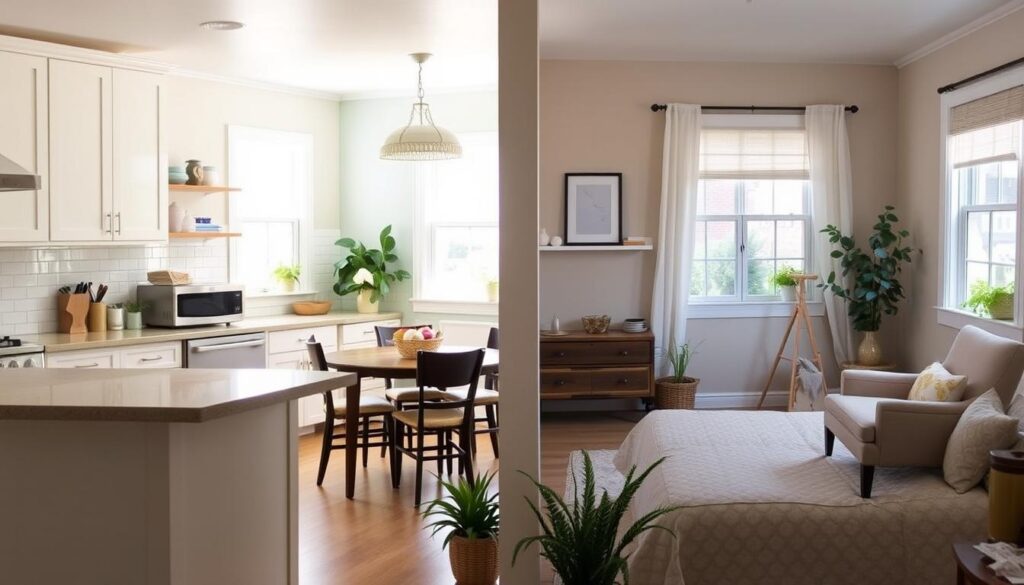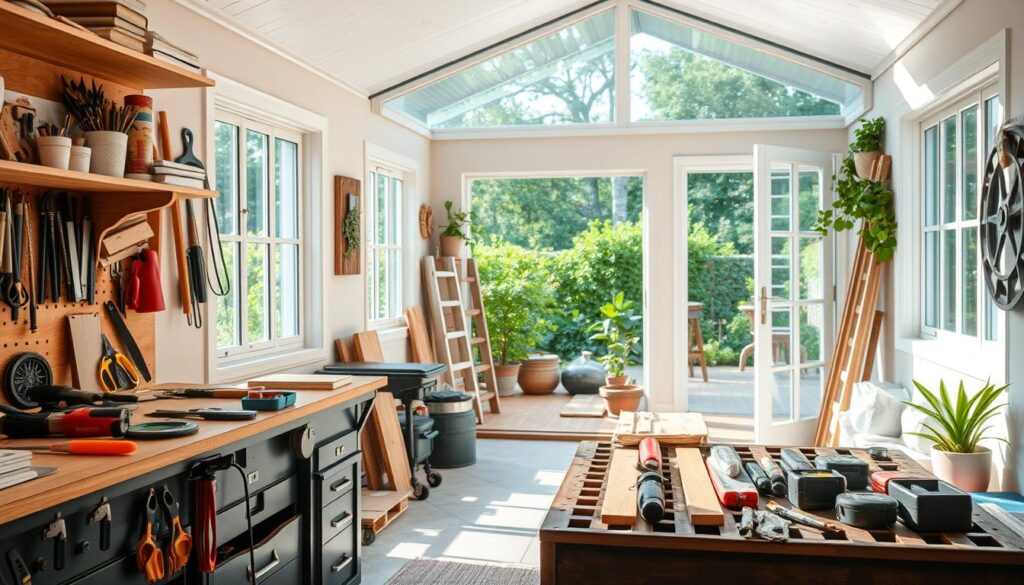Did you know that the average American homeowner could gain over $40,000 in equity by investing just 10% of their home’s value in smart renovations? Your home isn’t just a place to live—it’s a financial opportunity waiting to be unlocked.
Whether you’re planning to sell soon or want to maximize your property’s worth, this guide reveals actionable home improvement tips and strategies to turn your house into a valuable asset. With housing markets shifting rapidly, understanding how to boost your home’s value isn’t just smart—it’s essential.
From choosing cost-effective upgrades to timing the market perfectly, we break down every step. Discover how even small changes, like upgrading fixtures or enhancing curb appeal, can create big returns. This guide combines expert insights and real-world examples to help you navigate every phase, from assessing your home’s current worth to finalizing renovations that matter most.
Let’s start by uncovering what truly drives value in your neighborhood and how you can act now to secure a brighter financial future for your home.
Getting Started: Assessing Your Home’s Worth
Understanding your home’s value starts with knowing what shapes its price. Home value isn’t just a number—it’s a mix of location, condition, and what others in your area are buying. To increase home value, you first need a clear picture of where you stand.
What Home Value Really Means
Think of your home’s value like a recipe. Key ingredients include:
- Location: Schools, shops, and safety
- Condition: Updated kitchens or roofs
- Market trends: What neighbors are selling for
Why It Matters to You
Knowing your home’s worth helps you:
| Benefit | Example |
|---|---|
| Plan upgrades | Invest in a new bathroom to increase home value |
| Secure loans | Use equity for education or emergencies |
| Sell smarter | Set the right price for your market |
Your home’s worth affects decisions today and tomorrow. Start by comparing recent sales in your area and noting what’s trending. Small insights now lead to bigger gains later.
Key Factors That Influence Home Value
Understanding what shapes your home’s worth is the first step in maximizing its potential. This real estate guide breaks down the top elements that affect value, helping you make informed decisions.
Location remains king. A desirable neighborhood with good schools, low crime, and easy access to amenities can boost your property’s appeal. Schools and local services like parks or grocery stores also play a role. Next, market trends matter—pricing compared to recent sales in your area shows what buyers are willing to pay.
- Home condition: Well-maintained roofs, plumbing, and HVAC systems avoid costly surprises.
- Updates: Modern kitchens or bathrooms add value, while outdated features may deter buyers.
- Layout: Open floor plans are popular, but space utilization varies by buyer preferences.
Renovations should align with your local market. A real estate guide highlights that smart upgrades—like energy-efficient windows or smart home tech—often pay off. Avoid over-customizing; focus on universal improvements most buyers value.
Keep an eye on zoning laws and neighborhood developments too. New construction nearby or planned infrastructure projects can impact trends. This real estate guide ensures you stay ahead of changes shaping your investment’s future.
Simple Steps for a Preliminary Home Evaluation
Understanding your home’s value starts with two simple actions: studying the market and inspecting your property. These steps give you a clear starting point for improving your home’s appeal and resale potential. Let’s explore how to begin.
Checking Local Market Trends
- Research recent home sales in your neighborhood using platforms like Zillow or Redfin. Compare prices of homes similar to yours.
- Track price changes over the past year. Rising trends might signal opportunities for home renovation ideas that boost value.
- Note which upgrades—like modern kitchens or updated bathrooms—are common in high-selling listings.
Conducting a Visual Inspection
- Walk around the exterior. Check for cracked sidewalks, peeling paint, or overgrown landscaping.
- Inside, inspect floors, walls, and ceilings for damage. Note outdated fixtures or worn-out finishes.
- Make a list of repairs or updates that align with home renovation ideas popular in your area.
These steps highlight where small changes can have big impacts. Use your findings to plan cost-effective improvements that resonate with current buyer preferences.
Budget-Friendly Improvements to Boost Home Worth
Small upgrades can make a big difference in your home’s value—and even impact mortgage refinancing opportunities. Let’s look at proven, affordable steps that turn small investments into big returns.

- Paint exteriors. Replace or refresh doors and windows for a fresh look. Power-washing siding boosts curb appeal quickly.
- Refresh interiors. Swap outdated light fixtures, update kitchen hardware, or refinish hardwood floors to modernize spaces.
- Landscaping. Trim bushes, add mulch, or plant seasonal flowers for instant curb upgrades.
| Upgrade | Cost | ROI Potential |
|---|---|---|
| Exterior Door Replacement | $500-$1,200 | 65-85% |
| Light Fixture Update | $150-$400 | 90-100% |
| Landscaping Overhaul | $300-$1,000 | 150-200% |
Choosing neutral paint colors maximizes appeal for buyers and lenders. A well-maintained exterior signals care to both markets. According to Curbio’s guide, 77% of buyers prioritize move-in-ready homes, making these upgrades essential. Even minor fixes like window casings or updated door hardware can signal quality to lenders, potentially improving mortgage refinancing terms. Prioritize projects with the highest visibility and affordability—like repainting or lighting—to maximize equity gains without overspending.
Expert Tips for Effective Renovations
Smart renovations can protect and grow your home equity without overspending. Start by focusing on projects that deliver the biggest payoff. Experts advise aligning upgrades with what buyers value most in your neighborhood.
- Invest in kitchens: Modern updates like quartz countertops or energy-efficient appliances add visible value.
- Renovate bathrooms: Updating vanities, lighting, and fixtures can boost home equity by up to 80% of costs, per Remodeling Magazine’s Cost vs. Value Report.
- Enhance curb appeal: Fresh paint, landscaping, and new entryways make a strong first impression.
Hiring the Right Professionals
- Check licenses and insurance to avoid liability risks.
- Request portfolios and references from at least three contractors.
- Use written contracts specifying timelines, materials, and payment schedules.
Research local building codes before starting—noncompliant work could devalue your property. Ask contractors how their work aligns with current market trends to maximize home equity gains.
Implementing the Strategy: Unlocking the Value of Your Home
Now that you’ve identified opportunities to enhance your home’s value, it’s time to turn plans into action. Start by focusing on budget-friendly upgrades that align with your goals. Use the research from earlier steps to prioritize projects that deliver the most impact without overspending.
- Begin with small, high-return projects first. Paint walls, update fixtures, or install energy-efficient lighting—these changes cost less but boost curb appeal and function.
- Track local market trends to time your efforts. Follow platforms like Zillow or Redfin to see what nearby homes are highlighting. Mimic popular budget-friendly upgrades in your area to stay competitive.
- Stick to your budget. Allocate funds for both immediate fixes and long-term investments. Save receipts to document improvements for future equity calculations.
Involve contractors who specialize in cost-effective solutions. Ask for quotes comparing basic and premium options to stay within your plan.透明度和清晰度是关键,确保每一步都与增加房屋价值的目标一致.
Consistency matters. Regularly reassess your progress using online tools like the National Association of Realtors’ valuation guides. Adjust your approach as trends shift, but keep your core strategy focused on budget-friendly upgrades. With each step, you’re not just improving your space—you’re building lasting value that grows with time.
Navigating the Market: Timing and Trends
Timing plays a big role in maximizing your home’s value. Market trends shift with seasons and over years, so knowing when to act can make a big difference. Let’s look at how to track these changes and use them to your advantage.
Two key areas to watch are seasonal timing and long-term shifts in your local real estate scene. Here’s how to read the signs:
Seasonal Considerations
- Spring sales often peak as buyers are more active in warmer months.
- Fall is ideal for renovations to finish before holiday markets.
- Winter’s slower pace can mean better contractor pricing deals.
Long-Term Market Insights
Track yearly changes using data like this:
| Year | Annual Growth % | Key Factors |
|---|---|---|
| 2020 | 5.2% | Low interest rates |
| 2021 | 6.8% | Remote work demand |
| 2022 | 4.1% | Supply shortages |
| 2023 | 3.5% | Economic uncertainty |
| 2024 | 2.9% | Market stabilization |
Source: National Association of Realtors (2024)
Staying informed about both short-term and long-term market trends helps you decide when to sell, renovate, or hold onto your property. Use this info to make smart choices that boost your home’s value.
Legal and Financial Considerations for Home Improvements
When planning renovations, renovation advice often focuses on design and style. But legal and financial details are just as crucial. Let’s break down how to stay compliant and protect your investment.
Start by checking local building codes. Permits ensure your project meets safety standards and avoids costly fines. Working with licensed contractors is another must—they carry insurance and warranties, reducing liability risks.
Financing options matter too. A home equity loan uses your home’s value as collateral, offering lower interest rates. But compare terms carefully. Here’s what to prioritize:
- Verify contractor licenses via state databases
- Set aside 10-20% extra for unexpected costs
- Review insurance policies to cover construction risks
| Legal Steps | Financial Steps |
|---|---|
| Obtain permits upfront | Compare loan APRs |
| Contract review with lawyer | Use a renovation budget tracker |
Renovation advice often overlooks these details, but they’re vital. Protect your investment by balancing creativity with compliance. A well-planned approach ensures your home’s value grows without hidden setbacks.
Conclusion
You’ve got the tools to transform your home into a valuable asset. Strategic staging, smart pricing, and curb-appeal upgrades create an inviting space that attracts buyers. Professional photography and skillful negotiation seal the deal, ensuring you get top dollar. But remember, every improvement starts with knowing your market—research trends and trends to stay ahead.
Before breaking ground, always verify local regulations. Legal home improvements ensure your upgrades meet codes and boost resale value without hidden pitfalls. Pair this with budget-friendly fixes from earlier steps, and you’ll build a plan that works for your wallet and your goals.
Maximizing your home’s worth isn’t just about DIY projects—it’s a mix of strategy, timing, and knowledge. Explore proven techniques to refine your approach. Whether updating landscaping or negotiating offers, every choice moves you closer to a successful sale.
Start small: Audit your curb appeal today or compare market prices. Each step, from repairs to marketing, adds up. With the right mix of preparation and expertise, you’ll unlock your home’s full potential. The path is clear—what’s next?



